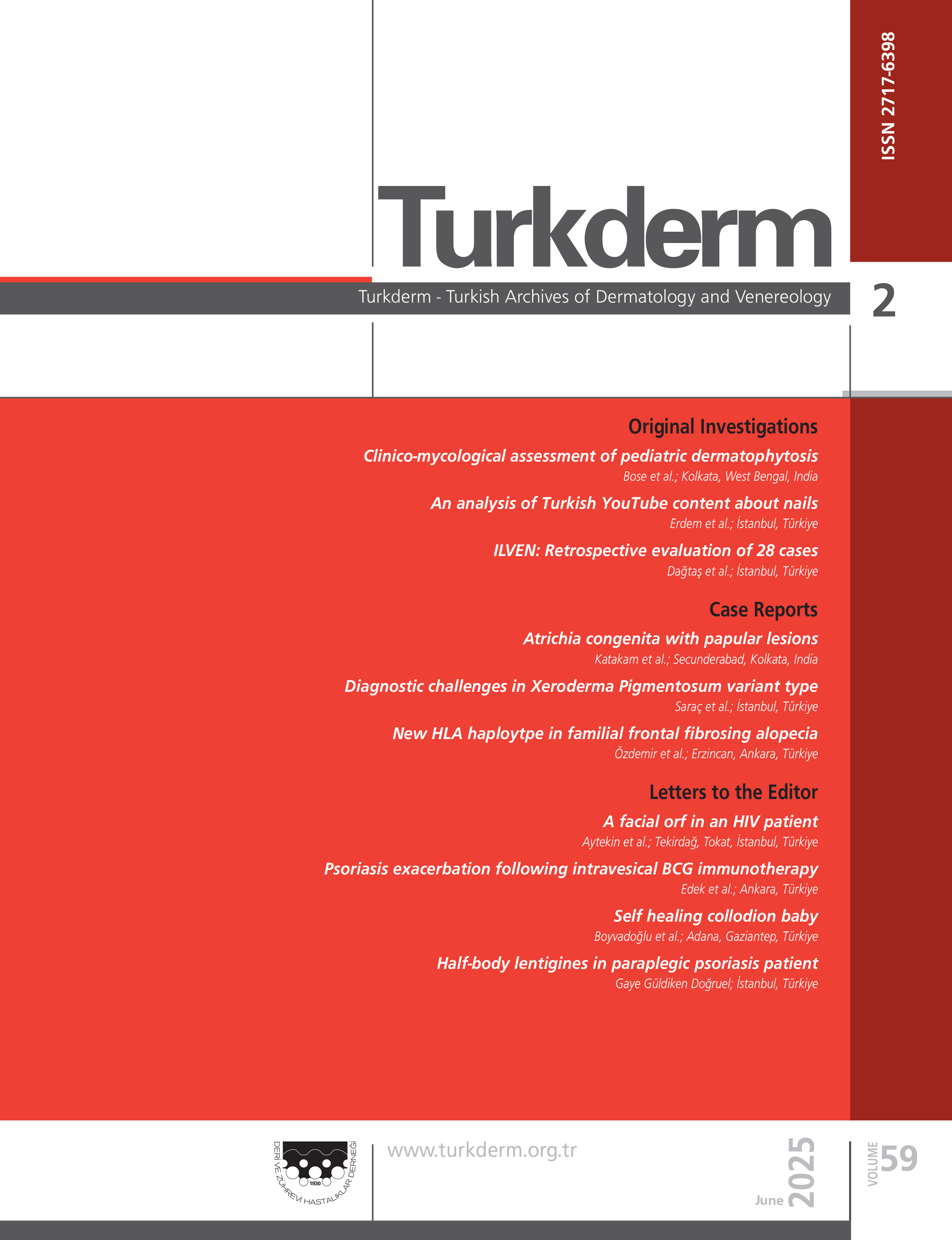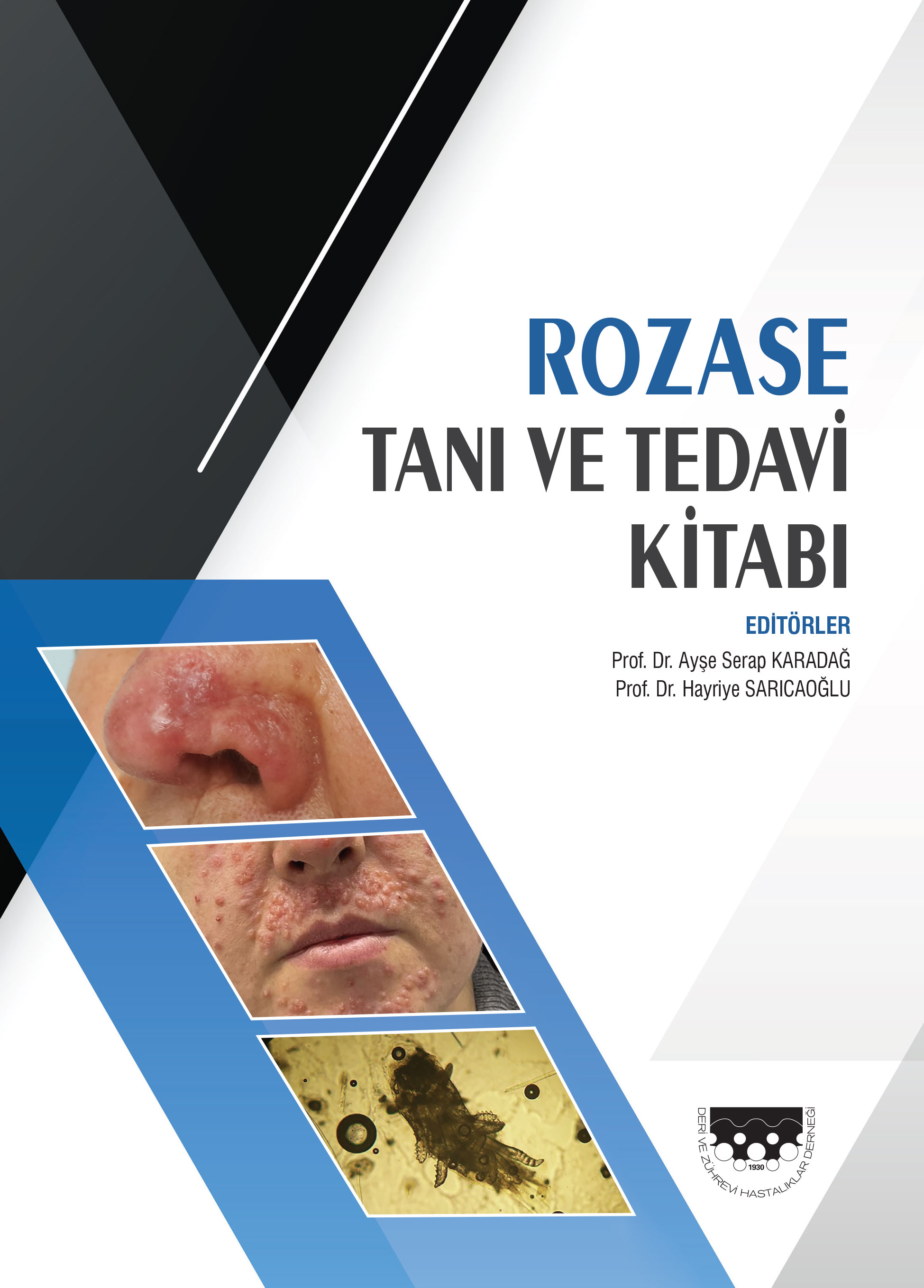Volume: 43 Issue: 2 - 2009
| EDITORIAL | |
| 1. | Kongrelerimiz ve Derneklerimiz Ertuğrul H. AydemirPage 43 Abstract | |
| REVIEW ARTICLE | |
| 2. | Treatment Approaches for Cutaneous Leishmaniasis Sema Aytekin Pages 44 - 47 Cutaneous leishmaniasis (CL) is a widespread tropical infection caused by numerous different species of Leishmania protozoa. In our country, CL is due frequently to L. major and L. tropica. Its clinical presentation is extremely diverse. Treatment of CL aims to prevent mucosal invasion, to accelerate the healing of skin lesions, and avoid disfiguring scar. Local and physical treatment modalities including topical paromomycin, cryotherapy, localized controlled heat, carbon dioxide laser therapy, or pentavalant antimonals can be effective against. Intralesional antimonals are still the drug of choice may patients. WHO recommends an injection of drug under edges of the lesions and the entire lesion until the surface has blanched. Parenteral antimonials are useful for large, persistent or recurrent lesions. Combinations with other drugs such as allopurinol, pentoxifylline must be used for antimony unresponsive lesions. |
| ORIGINAL INVESTIGATION | |
| 3. | Investigation of Serum Leptin Levels in Psoriatic Patients Nurhal Mercan Bozkurt, Mehmet Yıldırım, Ali Murat Ceyhan, Yusuf Kara, Hüseyin Vural Pages 48 - 52 Background and Design: Psoriasis is a chronic, T cell mediated hyperproliferative skin disease. Leptin is an adipokine that stimulates Th1 immune response while suppressing Th2 immune response. Because that leptin plays an important role in the T cell immunity, it is aimed to investigate the relation between psoriasis and leptin and whether leptin plays a role in the immunopathogenesis of psoriasis in the present study. Mateiral and Method: Serum leptin, interleukin (IL)-1b, IL-6, IL-8, TNF-a and nitric oxide (NO) levels were measured in 54 psoriatic patients and age, sex and body mass index matched 50 healthy control subjects. Results: The mean serum leptin concentration was not statistically different in psoriatic patients compared with the controls (p=0.568). Serum leptin levels were not correlated with PASI score, duration and clinical type of the disease as well as IL-1b, IL-6, IL-8, TNF-a and NO levels. IL-8 and TNF-a levels were significantly higher in patients with psoriasis than healthy control subjects (p=0.002 and p=0,020 respectively). The mean serum IL-1b, IL-6 and NO levels were not statistically different in patients when compared with control subjects. Conclusion: These results showed that leptin may not play a significant role in the immunopathogenesis of psoriasis and leptin could not be accepted as a marker to assess severity of the disease. |
| 4. | Serum High Sensitivity C Reactive Protein and Homocysteine Levels in Patients with Mild to Moderate Psoriasis Didem Didar Balcı, Zafer Yönden, Çiğdem Asena Doğramacı, Nizami Duran Pages 53 - 57 Background and Design: Psoriasis has been reported to be associated with increased cardiovascular risk profile. High sensitivity C reactive protein (hs-CRP) and homocysteine (Hcy) have been demonstrated to be novel biomarkers for subsequent cardiovascular events. The aim of the present study was to examine hs-CRP, Hcy and folic acid levels in patients with mild to moderate psoriasis vulgaris. Material and Method: Fifty one consecutive patients with mild to moderate psoriasis vulgaris and thirty two sex- and age-matched healthy controls were included in this study. After excluding factors that may affect serum Hcy levels, blood samples were obtained for hs-CRP, Hcy and folic acid determination. Lipid levels were also evaluated. Results: The mean Hcy values of the psoriasis patients was significantly higher, compared with the controls (p=0.001). There were no significant difference in hs-CRP and folic acid levels between psoriasis patients and controls (p>0.05). The total cholesterol (TC) high density lipoprotein cholesterol (HDL C) ratio was significantly higher in patients with psoriasis than in controls (p=0.044). There was a significant relationship between Hcy level and sex in psoriasis patients. The hs-CRP values had significant positive correlation with body mass index (BMI) and TC in psoriasis patients (p<0.05). Conclusion: Serum hs-CRP and folic acid levels did not show any significant difference between patients with mild to moderate psoriasis and controls. However, serum Hcy levels increased and inversely correlated with folic acid levels in psoriasis patients. These biomarkers could provide additional information in the evaluation of the atherosclerotic risk in psoriasis. |
| 5. | Sympathetic Skin Response in Patients with Vitiligo Asena Çiğdem Doğramacı, Esra Emine Okuyucu Pages 58 - 60 Background and Design: The sympathetic skin response (SSR) is a electrophysiological test used as an index of sudomotor sympathetic function. The aim of this study was to evaluate possible sympathetic nervous system dysfunction in vitiligo patients with the sympathetic skin response. Material and Method: Sympathetic skin response was studied in 26 patients (20 female and 6 male) with clinical definitely generalized vitiligo and 23 healthy controls (18 female and 5 male). This study was performed in a semi-darkened room while the patients were in supine position. SSR recordings in all of the subjects were performed by a Medelec electroneuromyograph. Results: The average age of patients and controls were 30.6±12.8 and 29.7±10.5, respectively. No demographic differences existed statistically between patients and controls (p>0.05). The mean latency of SSR in vitiligo patients [mean SSR latency in patients, 1.48±0.58 ms vs controls, 1.52±0.46 ms (p=0.944)] was not significantly different compared with the controls. The mean amplitude of SSR in vitiligo patients (mean SSR amplitude in patients, 3.83±2.95 mV vs controls, 5.09±3.60 mV) was smaller compared with the controls, but this difference was not significant (p=0.100). Conclusion: We conclude that vitiligo has no significant effect on the sympathetic skin response. |
| 6. | Subclinical Peripheral Neuropathy in Behcets Disease Esra Emine Okuyucu, Didem Didar Balcı, Ayşe Turhanoğlu, Taşkın Duman, Serkan Yılmazer, Jülide Zehra Yenin Pages 61 - 64 Background and Design: Central nervous system involvement is well known in patients with Behcets disease but studies evaluating peripheral nervous system is not usual. The aim of this study is to evaluate the frequency and characteristics of subclinical neuropathy in patients with Behcets disease. Material and Method: Thirty three Behcets disease patients (23 male, 10 women) with no evident neurological sign and symptom and 33 healthy volunteers were enrolled to the study. To exclude the other causes of peripheral neuropathy, some laboratory investigations were made. Electrophysiological studies of peripheral nerves were performed to all patients and healthy volunteers. The results were assessed according to the American Diabetes Association Diabetic Neuropathy Protocol. Results: Nerve conduction studies were abnormal in 11 of 33 patients (7 men, 4 women; 33.3%). Five patients (15%) had sensorymotor polyneuropathy, 4 (12%) has sural sensory polyneuropathy, 1 (3%) had median and tibial motor neuropathy. Sural nerve were unobtainable in 7 (21%) patients. 2 patients (6%) had prolonged F latency. Control group were normal electrophysiologically and the difference was statistically important (p<0.0001). There was no correlation between peripheral neuropathy and gender (p=0.696). Conclusion: Despite the detailed neurological examination, subclinical peripheral neuropathy can be seen in patients with Behçets disease. Electrophysiological studies are useful for the early detection of peripheral neuropathy in these patients. |
| CASE REPORT | |
| 7. | Charcot-Marie-Tooth Disease Type 2B Şenay Durdu, Kadriye Koç, Deniz Balaban, Aynur Karaoğlu Pages 65 - 67 Chatcot-Marie-Tooth (CMT) is also known as peroneal muscular atrophy and hereditary motor-sensory neuropathy (HMSN). It is the most commonly encountered inherited peripheral neuropathy. Actually, CMT is not a single disease, but is a group of disorders with similar symptoms. CMT type 2 is the second most common form after CMT type1. Symptoms usually begin in childhood or early adulthood. Mostly the peripheral nerves of the lower extremities and occasionaly upper extremities may be affected. Motor nerve involvoment induces distal muscle weakness and atrophy in the lower extremities that may result in foot deformities known as foot drop, pes cavus, pes planus, hammer toe etc. As a result of sensorial nevre degeneration, callus, recurrent foot ulcers, osteonecrosis, osteolysis and spontaneous amputation may accompany the disease. The speed of nerve conduction is not changed in the EMG, but axonal type sensorymotor semptoms that lead to a decrease of amplitude. We report here a 55 year old man with recurrent foot ulcers for 33 years and self amputations, whose EMG findings suggest acsonal neuropathy and who also has a 20 year - old son with similar complaints. |
| 8. | A Case of Kindler Syndrome Reyhan Çelik, Kadriye Koç, Deniz Balaban, Aynur Karaoğlu Pages 68 - 69 Kindler syndrome is a rare genetic disorder, acral blistering and photosensitivity appears from birth, followed by progressive poikiloderma and cutaneous atrophy. Kindler syndrome is caused by mutations in KIND-1 gene encoding the protein kindlin-1 which is involved in the attachment of the actin cytoskeleton to the extracellular matrix basal keratinocytes. Here we report a 18-year-old woman presented with generalized poikiloderma, webbing of the toes and fingers, palmoplantar hyperkeratosis, nail dystrophy, periodontitis and ectropione with a history of blister formation in early infant. |
| 9. | A Case of Mucormycosis Presented with Oral Ulcers Pınar Yüksel Başak, Emel Sesli Çetin, Hicran Yetkin, Vahide Baysal Akkaya Pages 70 - 72 A 62-year-old male patient suffering from oral ulcers and painful throat with pancytopenia was diagnosed as acute myeloid leukemia. Because of uncontrolled fever despite antibiotherapy and that Rhizopus spp. was identified from oral lesions, amphotericin B was added to treatment for two weeks. Oral lesions were completely cleared thereafter and this case was presented to point out that mucormycosis must be kept in mind in the differential diagnosis of oral mucosal lesions in patients with immunosuppression as well as it is a rare disease with high mortality. |
| WHAT IS YOUR DIAGNOSIS? | |
| 10. | A Rare Cause of Congenital Hearing Loss Hayrullah Alp, Esma Alp Pages 73 - 74 Abstract | |
| TURKDERM-6637 | |
| 11. | Acı Kaybımız Page 75 Abstract | |
| 12. | Haberler Pages 76 - 77 Abstract | |
| NEW PUBLICATIONS | |
| 13. | Shimuzus Textbook of Dermatology Page 78 Abstract | |
| TURKDERM-6637 | |
| 14. | KONGRE TAKVİMİ Page 79 Abstract | |























